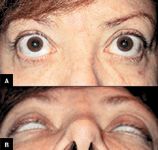Article
Techniques: an update on surgical decompression for thyroid eye disease
Currently, surgeons are employing combination techniques of bone and fat decompression to treat thyroid eye disorders, depending on the clinical situation. Prospective studies are needed to establish the ideal operative approach to minimize postoperative complications with the best cosmetic outcome in mind. Despite the multiple options available, it is most important to tailor the surgical approach to meet the individual needs of the patient.

Key Points


Increasing orbital volume

Conventional methods of bony decompression target the medial wall and orbital floor. Advantages of the inferomedial approach include a large volume decompression, up to 15 ml in cadaveric studies, with a relatively small incision.3 Moreover, the medial wall is targeted in cases of progressive optic neuropathy, in which the orbital apex must be adequately decompressed.

Though inferomedial decompression provides excellent volume enhancement, it is associated with a high incidence of postoperative diplopia, up to 60% in some case series.7 This largely has been attributed to asymmetric decompression, resulting in inferomedial displacement of the globe. Multiple strategies have been proposed to minimize postoperative diplopia and hypoglobus, including preservation of the medial-orbital strut, which provides bony support to the orbit and serves as a site of attachment of multiple globe-supporting ligamentous structures.8
Newsletter
Don’t miss out—get Ophthalmology Times updates on the latest clinical advancements and expert interviews, straight to your inbox.




